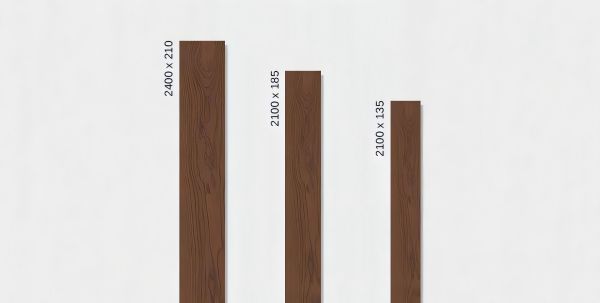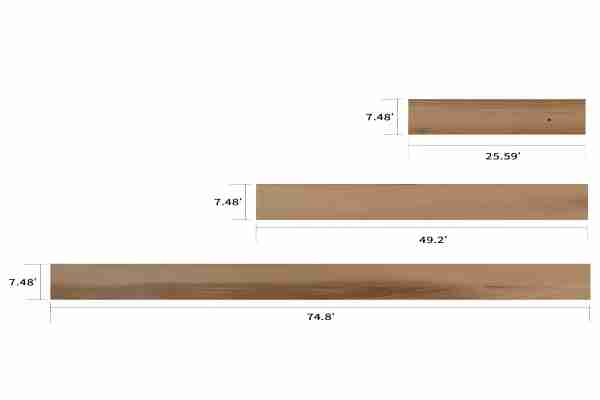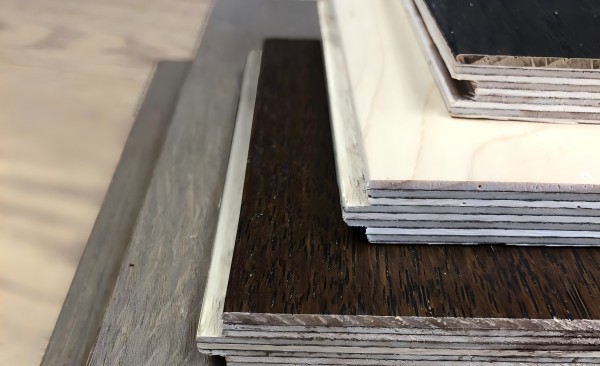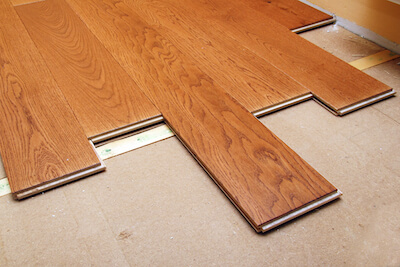Numerous consumers struggle to select the appropriate size for engineered flooring. They often wonder which dimensions best suit their space, style, and budget. This article provides professional advice to help you navigate these options, ensuring the perfect fit for your home and enhancing its overall aesthetic appeal.
Table of Contents
ToggleUnderstand Engineered Wood Flooring Size
When selecting engineered flooring, it’s important to consider the planks’ three dimensions: width, length, and thickness.

Plank Width:
- Narrow Width: Typically ranges from 3 to 5 inches (75 to 125 mm). Narrower planks are traditional and can make a space feel more classic.
- Medium Width: Generally between 5 to 7 inches (125 to 180 mm). Medium-width planks are versatile and offer a balanced look suitable for most spaces.
- Wide Width: Ranges from 7 to 10 inches (180 to 250 mm) or more. Wide planks create a modern and spacious appearance and are often used in larger rooms to emphasize the flooring.

Plank Length:
- Short Length: Typically around 2 to 4 feet (600 to 1200 mm). Planks with shorter lengths are more manageable and suitable for cramped spaces.
- Standard Length: Ranges from 4 to 6 feet (1200 to 1800 mm). Standard lengths are typical and provide the room with a balanced appearance without being overpowering.
- Long Length: Over 6 feet (1800 mm) and can go up to 8 feet (2400 mm) or more. Longer planks are often used for a more elegant and seamless appearance, especially in large rooms.

Plank Thickness:
- Thin: Around 3/8 inch (9.5 mm). Thinner planks are often more affordable and suitable for areas with height restrictions.
- Standard: Typically 1/2 inch (12 mm) to 5/8 inch (16 mm). Standard thickness provides a good balance of durability and comfort underfoot.
- Thick: Usually 3/4 inch (19 mm). Thicker planks offer enhanced durability and can be refinished more times, making them a long-lasting option.
Wear Layer Thickness:
The wear layer, which is the top layer of real wood, also varies in thickness. Common wear layer thicknesses are:
- Thin Wear Layer: 0.6 mm to 2 mm – Less durable, suitable for areas with light foot traffic.
- Standard Wear Layer: 2 mm to 4 mm – Suitable for moderate traffic areas and can be refinished once or twice.
- Thick Wear Layer: 4 mm to 6 mm or more – Ideal for high traffic areas and can be refinished multiple times.
Terminology and Measurements
Engineering floor measurement units vary by country, including square feet (inch)in the USA and square meters(mm)in most of the world. Understanding these units will help you choose the right size.
| Feature | Type | Square feet (Inches) | Square meters(mm) |
| Plank Width | Narrow Width | 3 to 5 inches | 75 to 125 mm |
| Medium Width | 5 to 7 inches | 125 to 180 mm | |
| Wide Width | 7 to 10 inches | 180 to 250 mm | |
| Plank Length | Short Length | 2 to 4 feet | 600 to 1200 mm |
| Standard Length | 4 to 6 feet | 1200 to 1800 mm | |
| Long Length | Over 6 feet | Over 1800 mm | |
| Plank Thickness | Thin | 3/8 inch to 1/2 inch | 9.5 mm-12.7mm |
| Standard | 1/2 inch to 5/8 inch | 12 mm to 16 mm | |
| Thick | 5/8 inch to 3/4 inch | 16 mm to 19 mm | |
| Wear Layer Thickness | Thin Wear Layer | / | 0.6 mm to 2 mm |
| Standard Wear Layer | / | 2 mm to 4 mm | |
| Thick Wear Layer | / | 4 mm to 6 mm |
Factors to Consider When Choosing Flooring Size
1. Room Size
- Proportions: Larger rooms can handle wider and longer planks, which can enhance the spaciousness of the area. Smaller rooms might benefit from narrower or shorter planks to avoid overwhelming the space.
2. Design Aesthetics
- Style Compatibility: Your home’s general design style should be complemented by the flooring’s size. For instance, wider planks may suit a modern, minimalist decor, while narrower planks might be more appropriate for traditional settings.
- Visual Impact: The way that different sizes appear in a room can change its perceived size significantly. Smaller planks can offer texture and pattern, while larger planks generally give a more open appearance.
3. Installation Method
- Ease of Installation: Wider and longer planks might be more challenging to install, especially in complex room layouts with many corners or obstacles.
- Method Suitability: Certain sizes might be more compatible with specific installation methods, such as floating, glue-down, or nail-down. For instance, thicker and wider planks often provide greater stability for floating floors.
4. Durability and Stability
- Thickness: Planks with a higher thickness often have greater durability and can withstand more abrasion. They are also more stable, which is particularly important for larger areas or rooms with heavy furniture.
- Wear Layer: Planks with a higher thickness often have greater durability and can withstand more abrasion. A thicker wear layer allows for multiple refinishings over the years.
5. Maintenance and Repair
- Ease of Replacement: Consider the ease of replacing individual pieces of flooring. It could be simpler to replace smaller tiles or boards without causing any damage to the remaining portion of the floor.
6. Subfloor Requirements
- Subfloor Compatibility: Heavier and thicker flooring might require a sturdier subfloor. Ensure your subfloor can support your choice, especially if opting for natural stone or thicker hardwoods.
7. Budget
- Cost Efficiency: Because they require more materials and require more labor to produce, larger tiles or planks typically cost more.
- Your budget might influence the size and type of flooring you choose.
Common Applications of Different Flooring Sizes
Narrow planks (3 to 5 inches )are best suited for
- Smaller Rooms: Narrow planks, typically ranging from 3 to 5 inches in width, can make small rooms appear larger. The more seams between planks can visually expand the space, making it seem less cramped.
- Traditional Designs: The classic look of narrow planks complements traditional interior designs well. They are frequently utilized in old buildings or other settings where a feeling of craftsmanship and timelessness is desired.
- Intricate Patterns: Their smaller size allows for the creation of intricate patterns, such as herringbone or chevron, which add visual interest and a custom feel to the flooring.
Wide Planks (7 to 10 inches )are best suited for
- Larger Spaces: Wide planks, which are typically 7 inches or more in width, can enhance the spacious feel of large rooms or open areas. They reduce the number of seams, creating a clean, modern look.
- Modern Aesthetics: Perfect for contemporary or minimalist decor, wide planks offer a sleek, updated look. Their immensity commands attention and can serve as the room’s design centerpiece.
- Continuity in Open Floor Plans: In homes with open floor plans, wide planks can help unify different living spaces into a cohesive whole, enhancing the flow from one area to another.
Long Planks (7 to 10 inches ) are best suited for
- Open Floor Plans: Long planks, often exceeding 6 feet in length, are excellent for open layouts where a continuous visual flow is desired across multiple connected spaces.
- Elegant Aesthetics: The extended length of these planks can convey a luxurious and expansive feel, making them ideal for formal living areas or large, upscale commercial spaces.
- Fewer Joints: The longer the plank, the fewer the end joints, resulting in a smoother, more uninterrupted floor surface that enhances the aesthetic and makes maintenance easier.
Thin Wear Layer (0.6 mm to 2 mm) is best suited for
The amount of times the flooring can be sanded and refinished is restricted by a thin wear layer. Less suitable for high-traffic or commercial environments due to reduced durability.
- Residential Areas with Low Traffic: Suitable for rooms that aren’t frequently used, such as guest rooms or formal dining areas. The thin wear layer can handle occasional foot traffic without significant wear.
- Rental Properties: Ideal for budget-conscious installations in rental properties where long-term durability is less of a concern compared to initial investment costs.
- Temporary Installations: Good for settings where the flooring might be replaced or upgraded within a few years, such as in temporary housing or staging homes for real estate sales.
- Decorative Purposes: Suitable for areas where aesthetic appeal is more important than durability, such as in decorative nooks, insets, or less trafficked hallways.
Thick Wear Layer (4 mm to 6 mm) is best suited for
A thick wear layer permits multiple refinishing, extending flooring life and proving cost-effective over time despite higher initial costs, due to enhanced durability and reduced maintenance.
- High Traffic Residential Areas: Excellent in living rooms, hallways, and kitchens, areas of the house where a lot of foot traffic occurs. The thick wear layer provides resistance to dents, scratches, and other wear.
- Commercial Spaces: Suitable for commercial settings such as offices, boutiques, and restaurants where there is moderate to heavy foot traffic.
- Institutional Settings: Ideal for schools, libraries, or other institutional settings where durability and the ability to withstand heavy use are crucial.
- Long-term Installations: Perfect for homeowners looking for a long-lasting flooring solution that won’t need to be replaced frequently. The flooring lasts longer when the surface may be refinished several times.
Conclusion
When selecting engineered hardwood flooring, consult manufacturers to consider the room’s size, design style, and traffic levels. Opt for wider, longer planks in large, open spaces for a modern look, and narrower, shorter ones in small areas for traditional aesthetics. Always balance durability, installation ease, and budget to make the best choice.

